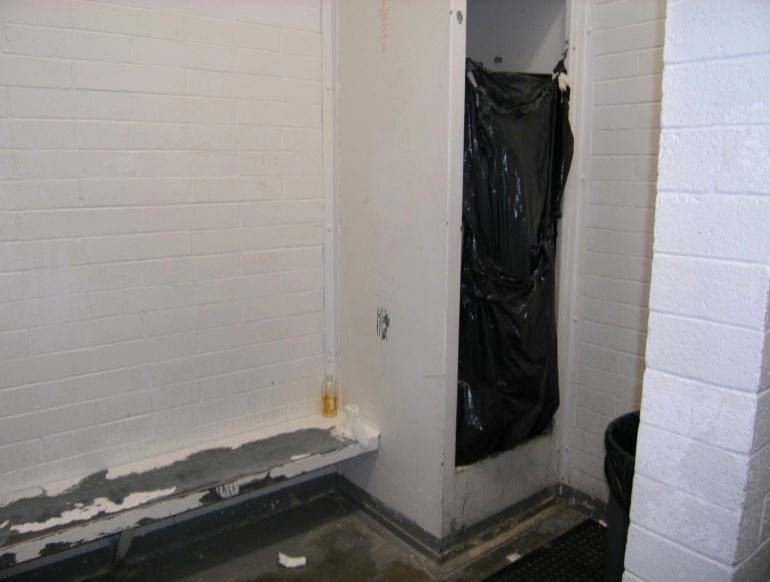
A Bureau of Indian Affairs detention center on the Blackfeet Nation once used a garbage bag as a shower curtain. Source: Office of Inspector General, U.S. Department of the Interior
Back home again at Northern Cheyenne
By Clara Caufield
Native Sun News Today Columnist
nativesunnews.today It’s great to be back home on the Northern Cheyenne Reservation after a seasonal break. And, to my great surprise, once again working for the Northern Cheyenne Tribe as the Acting Transit Manager, an unexpected development, but helpful for “rez” survival. Depending on how the tribal elections turn out, this could be either a very short or long term gig. Such is the nature of tribal employment. But, the job is a keen reminder of the critical need for transportation on reservations such as Northern Cheyenne. So many need rides for basic needs: employment, medical appointments, to get food from the grocery store or commodity center, to attend educational classes or other meetings. And many - especially as the end of the month approaches - are challenged to come up with coins for the very minimal fares. Thus, many people still resort to hitch-hiking. On my regular sojourn from Busby to Lame Deer, I am a regular picker-upper of hitch-hikers, which is a great way to make new friends and acquaintances. This week, one of my passengers was a Crow tribal member trying to make his way from Lame Deer, where he’d just been released from the BIA jail, trying to get back to Crow. Apparently, the police willingly transport those who are arrested on the Crow reservation to the Lame Deer jail, but upon release those people are on their own to make the 45 mile trip back to Crow. It is never a good idea to get arrested, but in the case of the Crows, it will be even worse when the winter sub-zero arctic conditions arrive and they find themselves hitchhiking back home. The personal experience he shared about the current situation facing Indian prisoners from reservations in the Great Plains area is hard to believe. First, the Crow reservation currently does not have a jail for people arrested by the BIA police there, the old jail having been condemned. Thus, prisoners from Crow are transported to the BIA jail at Lame Deer on the Northern Cheyenne reservation, where conditions were extremely crowded, even before this development. This fellow told of 35 people being crammed into a cell which had only 9 bunks. “We were laying “mat to mat” on the concrete floor and there was no room to even walk,” he said. Then he shared a recent experience of a jail tour which took him around much of Indian country. Sentenced to six months for disorderly conduct (in his case public intoxication) he was shuffled around from facility to facility, in the process meeting other inmates from many Montana, North Dakota, South Dakota and Wyoming Tribes who were in the same situation. His personal tour started at the Lame Deer BIA jail, continued to the Wind River BIA jail in Wyoming and ended up at a facility in Oklahoma, where the BIA foots the bill for many prisoners from the Great Plains area. Other inmates, he said, have the opportunity to go to Casper or Basin, Wyoming or facilities on other reservations. Across Indian country, certainly in Montana, Tribes have been adopting stronger laws, in response to meth and drug problems on reservations and the justice system is being tightened up. At Northern Cheyenne, for example, the Tribal Council recently adopted a new Law and Order Code which includes many new offenses and imposes longer sentences for most offenses. The end result seems to be many more prisoners facing longer sentences in tribal or BIA jails which are not equipped to handle the increased numbers. And what about the additional expense and manpower required transporting prisoners all over the country? That certainly must be a significant amount of time and money. When our Tribal Council adopted the new laws did they envision that many Cheyenne would wind up serving their time in Oklahoma? That’s one place the Northern Cheyenne have never favored. We were also prisoners there back in the late 1800’s. This is an example of poor planning, no planning or just bureaucratic bungling.

Read the rest of the story on the Native Sun News Today website: Back home again at Northern Cheyenne (Contact Clara Caufield at Acheyennevoice@gmail.com) Office of the Inspector General Reports:
Bureau of Indian Affairs Funded and/or Operated Detention Programs (February 2016)
Final Evaluation - Bureau ofIndian Affairs' Detention Facilities (March 2011)
Neither Safe Nor Secure: An Assessment of Indian Detention Facilities (September 2004) Copyright permission Native Sun News
Join the Conversation
